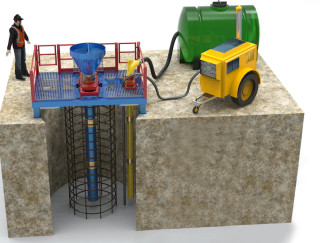Developments in concrete technology tend to be driven by the demands of the construction industry. As buildings and engineered structures become more complex, materials suppliers need to find ways of making their products stronger and easier to use.
This advancement in technology includes more complex use of admixtures to control concrete’s properties. This might involve increasing its resistance to freezing and thawing, increasing strength or increasing its ability to bond to other materials, such as steel.
Equally, mixes might be developed that reduce mechanical defects such as shrinkage, segregation, cracking or permeability – or simply reduce the cost.
But while concrete technology evolves, specification and testing remain rooted in the past. Until recently the majority of deliveries to site were acceptance-checked solely by undertaking the well-known slump test.
The slump test is useful in evaluating the consistency and workability of fresh concrete before it cures. This gives a good indication of the ease with which the concrete will flow and conversely, it will also highlight an improperly mixed batch.
Its popularity is understandable, since it is a test that is relatively easy to perform with just basic apparatus and is useful in ensuring uniformity for different loads of concrete under field conditions.
For piling contractors, the ability to evaluate accurately the quality of concrete arriving on site is especially important when installing deep foundations under support fluids using the tremie technique.
For those unfamiliar with the technique, a tremie is typically a watertight pipe with a funnel shaped hopper at its upper end and a loose plug at the bottom or discharge end. It is used to place concrete below groundwater level.
The valve at the discharge end is used to de-water the tremie and control the distribution of the concrete. During concreting, air and water must be excluded from the tremie by keeping the pipe full of concrete.
Accompanying the growth in more complex construction, piling teams have noticed an increase in the number of projects experiencing quality issues resulting directly from problems with the concrete in such tremie applications.
Concrete placed at the base of a deep foundation element experiences extreme hydraulic and hydrostatic pressures. This can lead to ‘bleeding’ or segregation of the mix, the inclusion of voids, known as ‘honeycombing’ and insufficient cover of the reinforcement.

In response to the increase in such defects, the European Federation of Foundation Contractors (EFFC) in conjunction with the Deep Foundations Institute (DFI), set up a task force to investigate the issue. A working group was established and set about a two-stage challenge: issue a best practice guide and embark on a programme of scientific investigation and on-site testing to learn more about how best to assess and test foundation concrete.
The EFFC and DFI jointly published the first edition of the Best Practice Guide to Tremie Concrete for Deep Foundations in 2016, providing up-to-date guidance on the acceptability criteria and placement of fresh concrete in bored piles and diaphragm walls using tremie methods.
The second edition of the guide is due for publication this month (June) and will incorporate all the results of the recent testing that has been undertaken. Although the guide already sets out best practice guidance for the foundations in terms of design of the foundations, the concrete itself and the development and testing of the chosen mixes, the new edition moves this on considerably.
The guide has already had a positive impact and has even started to change the way the industry looks at concrete – not all mixes are the same and whilst slump tests are fine for concretes with low workability, tremie concretes are more complex. More widespread use of pressure filtration and bleed tests and the adoption of flow table tests in place of slump tests has brought a greater focus onto the subject.
Publication of the second edition of the guide no doubt will bring further insight and changes to the way that we operate. The Federation of Piling Specialists (FPS) will take an active part in promoting best practices, as well as working with structural designers and concrete suppliers to reduce the frequency of projects suffering from the effects of poor quality concrete.
It would be nice to think that the problems associated with tremie concreting will be solved with the publication of the new edition. That is probably wishful thinking; but at least the industry can use this knowledge to take another step towards the ultimate goal of zero defects.
Philip Hines is chairman of the Federation of Piling Specialists and UK managing director of Bachy Soletanche.
Best Practice Guide to Tremie Concrete for Deep Foundations, 2nd Edition, will be available on the EFFC website at the end of June 2018. www.effc.org
This article was first published in the June 2018 issue of The Construction Index magazine, which you can read for free at http://epublishing.theconstructionindex.co.uk/magazine/june2018/
UK readers can have their own copy of the magazine, in real paper, posted through their letterbox each month by taking out an annual subscription for just £50 a year. See www.theconstructionindex.co.uk/magazine for details.
Got a story? Email news@theconstructionindex.co.uk




